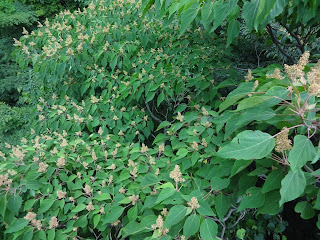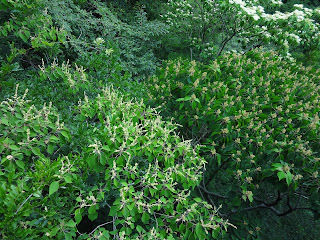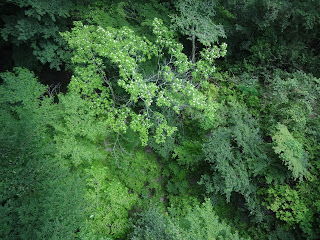Don’t
you think it’s something of human nature boasting “I have special something”?
That exclusive can be “Japanese endemic species” for Japanese forest, and so I
myself have said it many times in this blog. Though, we Japanese belong to only
one species, Homo Sapience, which
spreads everywhere on the Planet Earth. It’s natural to expect we find another
cosmopolitan species in the forest of Japanese archipelago, isn’t it? Recently,
I’ve learned there is one such kind. Pteriodophytes,
aka ferns.
 |
| Petris Cretica L. with mushrooms. This fern is really cosmopolitan. We can find it in Africa, Europe, Asia, and America. |
According
to Botanic Gardens Conservation International, Japan has roughly 7000 kinds of
flora where about 2900 (40%) of them are endemic. It is a bit of pride of us on
small islands. “Well, our nation is tiny compared with the continental
neighbors, but we have such a rich biodiversity of our own!” Hmmm … I simply
thought this applies for every plant of our land, ferns and moss included. In
addition, intricate hues of greens in ferns or moss match perfectly well with
Zen and tea ceremony both of which are the treasure of our culture. Look at the
beauty of moss garden in Zen temples! So, my unassuming brain regarded many
ferns we meet in our forest are uniquely Japanese, oh-so-Japanese plants. I was
naïvely wrong.
 |
| Beautiful
Polystichum polyblepharum, or Inode in Japanese, found in Miho CitizenForest 三保市民の森. It’s very common fern in Yokohama’s Citizen Forests. |
 |
| The
beloved cedar forest with ferns in Niiharu Citizen Forest 新治市民の森. |
According
to Atsushi Ebihara of National Museum of Nature and Science of Japan, when
analyzing their DNA, 31.7% of seed plants are endemic in Japanese natural
environment. In contrast, only 18%, or 112 species, of ferns are endemic and no
family of Pteriodophytes in Japan
belongs to endemic genus. (i.e. Japan has roughly 700-800 species of ferns in
total.) Ebihara said it might be due to insufficient coverage of field studies
about the genus. But the same families of Pteriodophytes
and Bryophyte (aka moss) often spread
all over the planet, regardless of Pacific, Atlantic, or Indian Ocean. Therefore,
it is not surprising for Japan having smaller uniqueness of ferns and moss, he
concluded. Wow. Is that so? Moreover, many Japanese endemic ferns are found in
remote islands such as Okinawa 沖縄, Ogasawara Islands 小笠原群島 or Yakushima 屋久島. i.e. Absolute
majority of the ferns and moss we find in Kanagawa Prefecture are international
kinds that have relatives who could live in the opposite side of the planet.
That’s … amazing. What a globalized world of ferns!
 |
| I
think it’s Thelypteris torresiana var.
clavata, or Himewarabe in Japanese. According to Wikipedia, we can find it in East and Southeast Asia, Australia, and North America. A globe trotter, it is. |
 |
| Thelypteris decursive-pinnata
(van Hall). Wikipedia says we can encounter it in South, East and Southeast Asia. Its siblings must be experiencing vigorous economic growth now … |
Then,
I’ve learned in the 19th century Britons were crazy about ferns, which created
a word “Pteridomania.” Of course, Chinese have been eating ferns for
millennium. In Hawaii, palapalai, aka
Microlepia strigose, is important
symbol for island culture. Kiwis of New Zealand have certainly a good reason to
take satisfaction in their unique world of ferns where they have rich list of
endemic species. Ashanti of Ghana has well-established symbol of Aya, i.e. fern fronds, in their Adinkra
symbols. Native American tribes, and people in Kerala of India have mythology
with ferns … ad infinitum.
 |
| Hena pattern which is one of the
standards of Liberty Print of London, with peacock-motif. When I bought it, I had a connotation with ferns somehow … |
 |
| And
actually, there is a fern called Maidenhair Fern, aka Adiantum pedatum, or Kujakushida in Japanese. “Kujaku” in Japanese means peacock. |
Come to
think of it, coals are fossils of ancient ferns some 300 million years ago.
Many ferns are survivors of Jurassic period, adopting their reproduction
strategy in keeping with changing environment for many many years. Patronizing
them as “uniquely ours” must be laughably nonsense for this miraculous plant.
Rather, they are patronizing us …? A sure thing is, finding their composed
green in a forest during this scorching summer is literally cool. Let’s have a
forest bathing next to ferns sighing in winds from mountain stream …
 |
Could you see in this photo
Lemmaphyllum microphyllum Presl (Mamezuta in
Japanese),
Crepidomanes Minutum (Uchiwagoke in Japanese),
and Adiantum monochlamys Eaton (Hakoneshida in Japanese)?
Mamezuta
can be found in East and Southeast Asia.
Hakoneshida
is for East Asia.
Uchiwagoke is
spreading all over
from Africa to Polynesia along the equator.
These tiny guys are
tough.
|
 |
| Bushes
of Hypolepis punctate (Thunb.) Mett. ex.Kuhn, or Iwahimewarabi in Japanese. Another regulars in East and Southeast Asia. In Japan it has reputation as a pioneer plant that comes out first after deforestation. |
 |
| Yeah, a baby cicada found the place near ferns was comfortable to be an adult … |
 |
| Just for our cooling-off … |
If you find an environmental issues
in Kanagawa Prefecture, please make a contact with Kanagawa Natural Environment Conservation
Center 神奈川県自然環境保全センター
657 Nanasawa, Atsugi City, 243-0121 〒243-0121 厚木市七沢657
Phone: 046-248-0323
You can send an enquiry to them by
clicking the bottom line of their homepage at http://www.pref.kanagawa.jp/div/1644/


















































